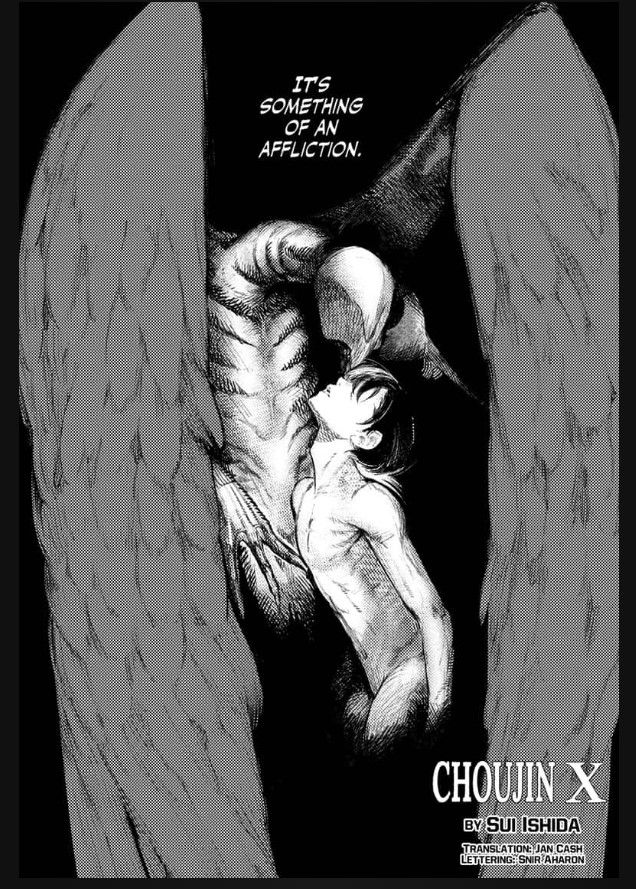 |
Introduction
I thought we’d seen the last of Ishida Sui when Tokyo Ghoul wrapped off with a whimper. Even if I was happy to see Kaneki and Touka together with a happy family, I mean that’s the least they deserve after all the suffering they’d been through, I can’t believe it ramped up to establish a hype ending. Only for a Deus Ex Machina to bail out what looked to be a tragic terminus, which made the finale equal parts confusing and pedestrian. In my opinion, no logical consistency whatsoever and a happy ending that came out of nowhere, culminating in the hype train derailing.
To me, it was clear Ishida was burnt out of ideas and thrown through the grinder, in terms of needing to meet his contractual obligations with Weekly Young Jump as a mangaka. Truly unfortunate. If you ask me, whenever he was fully inspired, he could write some of the most magical things – full of existential meaning and poetic beauty. One of a kind too in this Shounen terrain. Extinguished by the corporate demands coming from the upper crust at Shueisha, who didn’t see the series as being the work of art its creator perceived it to be because they correctly deduced that Tokyo Ghoul was going to be one of the biggest cash cows they could milk.
Yet here we are. Seems like Ishida Sui gets to demand a publication schedule that’s closer to his desired terms – featuring in the Tonari magazine, where sources suggest he’ll be publishing whenever he feels like it. Immediately, we start off with a plane crash induced by a mysterious entity – eponymously known as a ‘Choujin’ who seem to cause misfortune wherever they go. But somehow, all 200 passengers survive this crash – and my gut tells me it has something to do with the little girl asking for a tomato at the beginning. While there’s definitely more to this introduction than meets the eye, for most of the chapter, the series focuses on what I presume to be the protagonist of our story – Tokio Kurohara.
The Dichotomy of Choice
Inevitably, we’re going to be comparing Choujin X with Tokyo Ghoul. Maybe unfair, but it seems like the most logical starting point given that most people coming to read this manga will be reading it because Ishida Sui wrote Tokyo Ghoul. And I think a sensible place to being my discussion would be the dichotomy of choice, which is contrasted between these two series.
In Tokyo Ghoul, there was no choice for Kaneki. He was transformed into a ghoul against his own volition. He couldn’t even choose between being a ghoul or dying as a human, with no semblance of control over his destiny. While you could describe Tokio and Azama as essentially being forced to undergo transformation into Choujins, the element of choice remains. They chose to continue existing as Choujins rather than dying a dog’s death. In other words, coercion. Nevertheless, while there are great similarities between both sets of circumstances in Ishida Sui’s works, I believe this distinction should still be made.
Why? Tokio chose to become a Choujin so that he wouldn’t die and so that he could save Azama’s life. That starkly contrasts Kaneki’s lack of self-determination, because Tokio still made a conscious choice. A noble one too. I wonder how becoming a Choujin will alter Tokio’s underlying physiology. And if Tokyo Ghoul offers any point of reference, I’m confident that it will have a psychological impact upon Tokio as well. Azama passed out before he could properly transform, but I’m willing to bet my money on the idea that he will certainly turn out to be something special too.
Thoughts Going Forwards
Personally, I think the premise of Choujins doesn’t quite resonate the way Ghouls do. Choujins are shrouded in too much mystery at the moment. The serum clearly does some wacky stuff when injected into a person’s body and makes them less stable more psychopathic. But it doesn’t compare to the tragedy of being a ghoul – creatures who did not choose to be that way and are persecuted by society. Plus we saw Kaneki wrestle with his rationality against a predatory drive to kill humans and consume their flesh. And it was viscerally painful to see him becoming so broken by the internal struggle. Of course, we’re only one chapter in. Tokyo Ghoul was hardly a masterpiece in the making from its outset. And assuming Ishida’s given space, creative control and however much rest he needs, I’m excited to see what this outcome might be.
